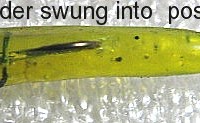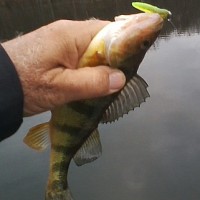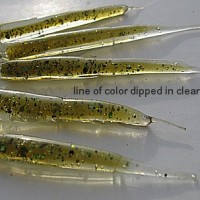My premise of lure choice is biology-based only on the capability of fish senses,
- not
intelligence and therefore I believe a fish does not know what a lure represents. I believe fish instinctively know a real prey animal when it sees it, but when it comes to lures, I choose those that stimulate a fish’s lateral line and that visually provokes the strike without any though process whatsoever.
*(the phrase artificial lure is not really accurate because it would indicate an artificial that is artificial)
Others who insist fish attack a lure based on being fooled into believing it is a prey animal may for all I know be right, but even those who match prevailing prey still choose lures based on lure characteristics they deem necessary and superior among lures of the same type. Color, size, shape, action, vibration/ noise, bill size, line size, etc. are key to whatever makes fish strike lures – hunger/feeding not always or even usually being the case. Most fish for all we know may just be hanging out, suspending, until something comes along.
We all experiment with lures at one time or other, searching for that perfect lure that always catches fish under certain conditions. Something that works at one time or other ( hopefully more often than not), is added to the tackle box. If we see a pink polk-a-doted grub catch fish after fish, outing after outing, we use it and are convinced because the lure proved itself.
Speculating on why a lure worked is beneficial so we may further test similar characteristics in other lures of the same or maybe even of a different design. None of this has anything necessarily to do with a prey species but still comes down to being fish sense-related. As as example of a lure breakdown as why it worked, the pink spotted lure possessed a bright color that is visual in clear or dingy water and in low light.The tail or body action stimulated the lateral line and got notices visually.
Regardless the premise of why we choose lure x, y, or z, the testing of any lure and using it day after day proves its value based on the lure’s characteristics that
- provoke
a strike.
Here are a few we take for granted:
color (dark, light or in between; fluorescent)
lure action (very little or high action)
flash (bright strobe-like)
vibration (unnatural)
shape (not usually realistic)
The combination of any of the above along with presentation, allow lures to catch fish as the designer intended. As you can see in the photo of the perch caught on a the grub, the grub has no tail. What makes the lure work so well (this one caught over 30 fish the day it was first used) I speculate was the waddle-of-the body with light pauses in the retrieve. It was a accidental hand-pour, but after looking at it laying there, I thought why not give it a try. The hand pours below it were based on that design as well as others.
If you compare pan fish lures sold, you might notice similarities in design such as the super thin tail and elongated body. Many soft plastic designs in many colors will catch almost all species of fish; the lures illustrated have caught 6 species in one day.
So when choosing lures, think lure characteristics vs what a lure might represent to a fish and note how well the lure works and then transfer those characteristics to other lures you might want to try.


